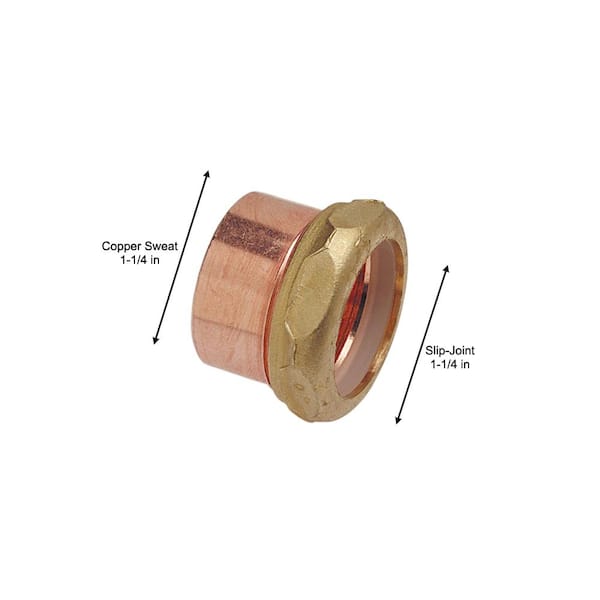Plumbing Adaptation: 1-1/4 Copper To PVC Adapter For Secure Connections

Plumbing Adaptation: 1-1/4 Copper to PVC Adapter for Secure Connections
Introduction
In the realm of plumbing, adaptability is paramount, and seamless transitions between dissimilar materials are essential for efficient and reliable systems. One such transition is the connection between copper and PVC pipes, which requires a specialized adapter to ensure a secure and leak-free seal. This article delves into the intricacies of 1-1/4 copper to PVC adapters, providing a comprehensive guide to their selection, installation, and maintenance.
Understanding the Need for Adapters
Copper and PVC pipes possess distinct characteristics that necessitate the use of adapters for their interconnection. Copper pipes, known for their durability and corrosion resistance, are commonly employed in older plumbing systems. PVC pipes, on the other hand, are lightweight, cost-effective, and resistant to chemicals, making them a popular choice in modern installations.
The difference in material composition and pipe diameters between copper and PVC pipes creates a challenge for direct connection. Adapters bridge this gap, providing a transition fitting that allows for a secure and leak-proof joint between the two materials.
Types of 1-1/4 Copper to PVC Adapters
The 1-1/4 copper to PVC adapter is a versatile fitting available in various configurations to accommodate specific plumbing requirements. The most common types include:
- Male Adapter: This adapter has a male copper threaded end and a female PVC socket end, enabling the connection of a copper pipe to a PVC pipe.
- Female Adapter: This adapter has a female copper threaded end and a male PVC spigot end, allowing the connection of a PVC pipe to a copper pipe.
- Union Adapter: This adapter consists of two separate fittings connected by a union nut. It provides flexibility in connecting and disconnecting pipes, making it ideal for maintenance and repairs.
Material Considerations
1-1/4 copper to PVC adapters are typically manufactured from high-quality materials to ensure durability and longevity. The copper end is usually made of lead-free brass or copper alloy, while the PVC end is constructed from chlorinated polyvinyl chloride (CPVC) or unplasticized polyvinyl chloride (uPVC).
The choice of material depends on the specific application and environmental conditions. CPVC is more resistant to high temperatures and chemicals than uPVC, making it suitable for hot water lines and outdoor installations. uPVC, on the other hand, is more economical and offers excellent resistance to corrosion and abrasion.
Installation Guidelines
Proper installation of 1-1/4 copper to PVC adapters is crucial for ensuring a secure and leak-free connection. The following steps provide a general guideline:
- Prepare the Pipes: Cut the copper and PVC pipes to the desired length and ensure they are clean and free of burrs.
- Apply Pipe Cement: Apply a thin layer of PVC pipe cement to the male PVC end of the adapter and the female PVC pipe end.
- Insert the Pipe: Insert the PVC pipe into the adapter, ensuring a snug fit. Hold the connection for a few seconds to allow the cement to set.
- Tighten the Connection: If using a male adapter, tighten the copper pipe into the adapter using a wrench. If using a female adapter, tighten the PVC pipe into the adapter using a pipe wrench.
- Test the Connection: Once the adapter is installed, turn on the water supply and check for any leaks. Tighten the connection further if necessary.
Maintenance and Troubleshooting
Regular maintenance and troubleshooting are essential to ensure the longevity and reliability of 1-1/4 copper to PVC adapters. The following tips can help prevent issues:
- Inspect Regularly: Periodically inspect the adapter for any signs of damage, corrosion, or leaks.
- Tighten Connections: If the connection becomes loose over time, use a wrench to tighten it.
- Replace Worn Adapters: If the adapter shows signs of significant wear or damage, it should be replaced promptly to prevent leaks.
Conclusion
1-1/4 copper to PVC adapters are essential components for connecting copper and PVC pipes, ensuring a secure and leak-free transition between these dissimilar materials. By understanding the types, materials, and installation guidelines for these adapters, plumbers and homeowners can ensure reliable and long-lasting plumbing systems. Proper maintenance and troubleshooting practices will further extend the life of these adapters and prevent costly repairs.